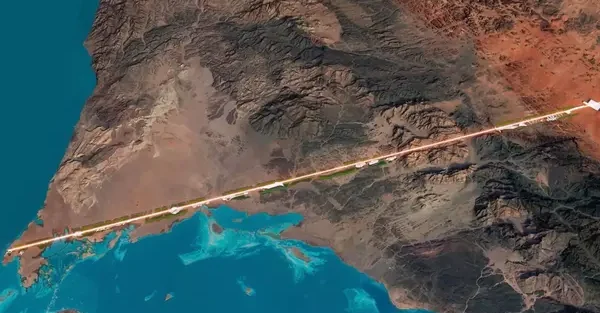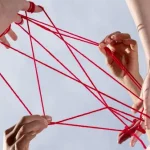Empty cities haunt China’s landscape like concrete monuments to ambition. Ordos, built for one million, houses 100,000. Kangbashi, designed for 300,000, barely shelters 30,000. Now Saudi Arabia plans something far more audacious: a 170-kilometer linear metropolis for nine million people.
With a population of 35.3 million, Saudi Arabia plans to move a quarter into THE LINE. Dubai took 50 years to reach 3.5 million residents, and NEOM projects THE LINE may take 100 years to complete.
Who Actually Moves to THE LINE?
NEOM officials remain vague about who will live in THE LINE. Promotional materials show diverse, international faces like tech workers, families, and entrepreneurs, but the actual demographic picture is more complex. The first phase target has already been reduced from 1.5 million by 2030 to fewer than 300,000, a challenging but more realistic goal for a brand-new desert city.
Meanwhile, young Saudis are leaving the country. Youth unemployment is at 13.8 percent, and many graduates are heading to cities like Dubai, London, and New York for opportunities beyond government jobs. While THE LINE aims to reverse this brain drain, Saudization laws continue to limit foreign talent. The contradiction is clear: a global city cannot be built while closing its doors to global workers.
Early residents are likely to include relocated government employees, construction workers and their families, early retirees attracted by tax-free living, tech entrepreneurs exploring incentives, and Gulf-based expatriates seeking fresh opportunities.
Singapore faced similar dilemmas. Lee Kuan Yew moved past ideology, opened the doors to international expertise, and transformed a small island into a global city-state. If this project is to work, it may require the same pragmatic mindset.
The Jobs Dilemma
A population of nine million needs around 4.5 million jobs, yet Saudi Arabia’s private sector currently employs only 3.2 million. THE LINE would need to create more jobs than exist in the rest of the country.
Residents will need essentials like grocery stores, schools, salons, and restaurants, but these rely on consumers with disposable income. Without core economic drivers like factories or corporate hubs, such services cannot thrive.
Manufacturing offers some hope, and Saudi Arabia is investing heavily to move beyond oil. Still, factories are typically built near ports, transport links, and resources, not in remote desert cities chosen for their visual appeal.
There is precedent for the improbable. In 1980, Shenzhen was a fishing village of just 30,000. Today it is home to over 13 million. Its rise was not driven by design, but by new economic opportunities. If this new city is to thrive, it must discover its own version of that economic catalyst.
The Money Question
Real estate in Riyadh and Jeddah is already unaffordable for many Saudis, and THE LINE’s projected costs suggest it will not offer affordable housing either. Housing nine million wealthy residents would require doubling the country’s high-income population. One possible solution is government subsidies to attract residents, effectively making THE LINE the most expensive social housing project ever attempted.
While feasible with sustained oil revenue, this depends on long-term financial stability. Brazil faced similar doubts with Brasília in 1957, yet political will prevailed as civil servants were relocated by decree. Over time, it became a functional city with over three million people, showing that political resolve can sometimes outweigh economic logic.
The Culture Clash
Saudi Arabia’s identity is deeply tied to nomadic traditions, where extended families often live together. THE LINE, with its mirrored walls and linear layout, could separate relatives by vast distances. Younger Saudis are increasingly drawn to global connectivity over traditional structures, and for some, THE LINE may offer a sense of freedom. The challenge is whether this appeals to enough people to overcome resistance from older generations. Designing for youth may alienate elders, while prioritizing tradition risks losing millennials. Balancing both will require an unprecedented level of social adaptation.
The Regional Poker Game
Every person who moves to THE LINE is one less for Dubai, Doha, or Abu Dhabi, making Gulf states competitors for talent and investment. If THE LINE succeeds, it may come at their expense. Similar projects are underway across the region, including Dubai South, Lusail, and Silk City. If they all succeed, the region stands to gain significantly. Collaboration could offer more long-term value than competition, but in the Gulf, politics often overrides logic..
The Environment Trap
THE LINE presents itself as a sustainable project, yet plans to air-condition nine million people in one of the world’s hottest regions. The energy required alone could power small countries, and water poses an even greater challenge, requiring massive desalination to meet basic needs. Still, constraints often lead to innovation.
Singapore, despite lacking natural freshwater sources, became a global leader in water management through recycling and desalination. THE LINE could lead in desert innovation, developing solutions that extend far beyond its borders, provided it focuses on meaningful progress rather than relying on overbuilt infrastructure.
The Latest Reality Check As of mid-2025, excavation and concrete works are progressing rapidly on THE LINE. The scaled-back 2024 approach remains: initial targets dropped from 1.5 million to fewer than 300,000 residents by 2030, focusing on 2.4 kilometers of the planned 170-kilometer structure.
NEOM executives now acknowledge the project will take around 100 years to complete, with stadium construction beginning in 2027. The project has moved from theory to active construction site, with steel and concrete rising from the sand. It’s no longer a question of whether THE LINE will be built, but how long it will take to become the city its planners envision.
The Long Game vs. The Short Game
Viewed over a century, the vision becomes more realistic. Brasília was once seen as madness. Manhattan began as swamp, Las Vegas as desert, and Dubai as dunes. Bold bets sometimes succeed.
But in the short term, delays carry risk. Each year without momentum allows other cities to attract talent, capital, and attention. Missed deadlines and scaled-back targets erode credibility. Urban development depends on sustained progress.
Beyond the Blueprint
THE LINE’s success is not about hitting population targets. It is about desirability. Nine million people must want to live there, not because of government mandates, futuristic architecture, or marketing promises, but because it offers something no other city does.
History shows that cities thrive when they provide jobs, opportunity, community, and hope. These remain the foundations of urban life.
China’s ghost towns remind us that building is not enough. Cities only succeed when people choose to stay. THE LINE may take a century to discover what people truly want. Construction is clearly happening.
What remains is proving this desert project can become more than construction, a place people willingly choose to build their lives around.





